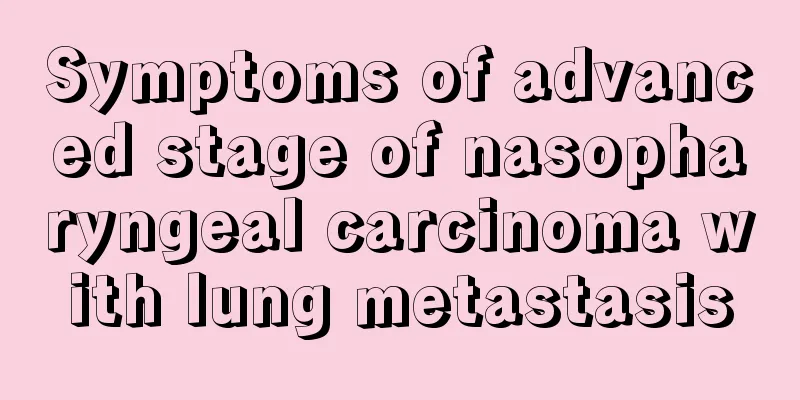Symptoms of advanced stage of nasopharyngeal carcinoma with lung metastasis

|
Nasopharyngeal carcinoma is a malignant tumor of the top and side walls of the nasopharyngeal cavity. It is one of the most common malignant tumors in my country, and its incidence rate ranks first among malignant tumors of the ear, nose and throat. With the continuous development of science and technology, our understanding of nasopharyngeal carcinoma has gradually deepened. Understanding the symptoms of nasopharyngeal carcinoma can help us nip nasopharyngeal carcinoma in the bud. The following are the symptoms of nasopharyngeal carcinoma. (I) In the early stage of respiration of mucus and mucus, there may be bleeding symptoms, such as blood in the sputum after suctioning the nose or blood in the mucus when blowing the nose. In the early stage, there is only a small amount of blood in the sputum or mucus, which may appear or disappear. In the late stage, there is more bleeding, and there may be nosebleeds. (II) Tinnitus, hearing loss, and a feeling of blockage in the ear When nasopharyngeal carcinoma occurs in the lateral wall of the nasopharynx, the lateral fossa, or the upper lip of the Eustachian tube opening, the tumor compresses the Eustachian tube and may cause unilateral tinnitus or hearing loss, and catarrhal otitis media. Unilateral tinnitus or hearing loss and a feeling of blockage in the ear are one of the symptoms of early nasopharyngeal carcinoma. (III) Headache is a common symptom, accounting for 60%. It can be the first symptom or the only symptom. In the early stage, the headache is not fixed in location and is intermittent. In the late stage, it is a persistent migraine with a fixed location. The cause of this may be caused by neurovascular reflex or stimulation of the first branch of the trigeminal nerve in early stage patients. In late stage patients, it is often caused by tumors destroying the skull base and spreading inside the skull to affect the cranial nerves. (IV) Diplopia. Due to the invasion of the abducens nerve by the tumor, double vision is often seen when looking outward. Invasion of the trochlear nerve often causes inward strabismus and diplopia, with diplopia accounting for most cases. (V) Facial numbness refers to numbness of the facial skin, with clinical examination showing decreased or absent pain and tactile sensation. Tumor invasion of the cavernous sinus often causes damage to the first or second branch of the trigeminal nerve; tumor invasion of the oval foramen, the anterior region of the styloid process, and the third branch of the trigeminal nerve often causes numbness or paresthesia of the skin in the anterior part of the auricle, the temporal region, the cheek, the lower lip, and the chin. Facial skin numbness accounts for 10 to 20 percent. (VI) Nasal congestion Nasal congestion may occur when the tumor blocks the posterior nostrils. When the tumor is small, the nasal congestion is mild. As the tumor grows, the nasal congestion becomes more severe, and is usually unilateral. If the tumor blocks both posterior nostrils, bilateral nasal congestion may occur. (VII) Symptoms of cervical lymph node metastasis Nasopharyngeal carcinoma is prone to cervical lymph node metastasis, about 60% to 80%, of which half are bilateral metastasis. Cervical lymph node metastasis is often the first symptom of nasopharyngeal carcinoma. In a few patients, the primary lesion cannot be found in the nasopharynx examination, and cervical lymph node metastasis is the only clinical manifestation. This may be related to the fact that the primary lesion of nasopharyngeal carcinoma is very small and extends to the submucosal tissue. (VIII) Tongue muscle atrophy and tongue deviation. Nasopharyngeal carcinoma directly invades or lymph nodes metastasize to the posterior styloid process or hypoglossal nerve canal, causing the hypoglossal nerve to be invaded, causing the tongue to deviate to the affected side, accompanied by tongue muscle atrophy on the affected side. (IX) Eye ptosis and eye fixation are related to damage to the oculomotor nerve. Visual impairment or loss is related to damage to the optic nerve or invasion of the orbital cone. (10) Distant metastasis The rate of distant metastasis of NPC is between 4% and 27%. Distant metastasis is one of the main reasons for the failure of NPC treatment. Common metastatic sites are bones, lungs, liver, etc., and simultaneous metastasis to multiple organs is common. (XI) Associated dermatomyositis Dermatomyositis may also occur with nasopharyngeal carcinoma. Therefore, the nasopharynx should be carefully examined for patients with dermatomyositis regardless of whether they have symptoms of nasopharyngeal carcinoma. (XII) Amenorrhea as the first symptom of NPC is very rare and is related to NPC invading the sphenoid sinus and pituitary gland. The nasopharynx is deep and hidden, and the local symptoms of malignant tumors in this area are not obvious. They often attract attention only after spreading to adjacent structures or metastasizing to lymph nodes. It is not uncommon for patients to first visit an ophthalmologist due to orbital pain, extraocular muscle paralysis, and exophthalmos. Advanced nasopharyngeal carcinoma often invades the optic nerve near the optic chiasm, causing decreased vision, nasal or temporal hemianopsia, and blindness in one or both eyes. Fundus examination reveals optic nerve atrophy. The abducens nerve has a long course and is located in an area that is easily invaded by nasopharyngeal carcinoma, so it is often invaded at an early stage, causing diplopia, inability to turn the eyeball outward, and esotropia. The trochlear nerve is affected, and the outer and lower rotation of the eyeball is restricted, causing difficulty in looking down. The oculomotor nerve is compressed, leading to eye movement disorders and ptosis. The ophthalmic branch of the trigeminal nerve is affected, resulting in numbness of the upper and lower eyelid skin and sluggish or absent corneal reflexes. The invasion of orbital tissue causes proptosis. In daily life, insist on physical exercise, eat a reasonable and healthy diet, know how to regulate your emotions, maintain a positive and optimistic attitude, be careful to prevent and pay attention to whether your body has the above symptoms, discover and treat them as early as possible, and increase the chance of recovery. |
<<: Is nasal bleeding a symptom of nasopharyngeal carcinoma recurrence?
>>: Stage 4 symptoms of nasopharyngeal carcinoma
Recommend
What harm does arsenic do to the human body
There are many trace elements in our body, and we...
Can people with cervical spondylosis sleep on latex pillows?
It is best for patients with cervical spondylosis...
What causes big toe pain?
People may walk a lot or stand for a long time ev...
Experts introduce to you what is central lung cancer
Among lung cancers, the incidence of central lung...
How is white sugar made
White sugar is a food that is rich in sweetness a...
Correct care reduces the recurrence rate of lymphoma
Oncologists say that lymphoma is the most serious...
Does it hurt to eat if you have thyroid cancer?
Patients with thyroid cancer generally do not exp...
Can osteosarcoma be completely cured?
Medically, osteosarcoma is a stubborn tumor disea...
Three Chinese medicine prescriptions for the treatment of esophageal cancer
Esophageal cancer is a malignant tumor that occur...
How to identify artificial eggs, these aspects will tell you
In everyone's impression, eggs are laid by he...
What are the differences between prostate cancer and bladder cancer? Teach you to distinguish the two cancers from the symptoms
Prostate cancer and bladder cancer are particular...
What to do if white clothes turn yellow after being soaked
Although white clothes look good and are easy to ...
What are the nursing measures for hypertension in ovarian cancer
Ovarian cancer is one of the most common tumors o...
There are so many benefits of sleeping naked for girls
In life, many female friends choose to sleep nake...
Postoperative care for bladder tumors should not be taken lightly
Patients with bladder tumors are almost always tr...









